The AMD Trinity Review (A10-4600M): A New Hope
by Jarred Walton on May 15, 2012 12:00 AM ESTAMD Trinity: Battery Life Also Improved
With all of the changes going into Trinity, one thing that hasn’t changed since Llano is the process technology. Trinity is once again coming on a 32nm process from GlobalFoundries. If we were talking about Intel, Trinity would represent a “Tock” on the roadmap—a new architecture on an existing process. We’ve looked at CPU and GPU performance, and this is a part that’s pretty much universally faster than its predecessor. Given the lengthier pipeline and Bulldozer-derived architecture, I admit that I was concerned Trinity might actually be a step back for battery life; it appears that my fears were unfounded, largely due to the improvements in Piledriver. As usual, we tested with all laptops set to 100 nits brightness in our idle, Internet, and H.264 playback tests. I also ran some additional tests which we’ll discuss in a moment. First, here are the standard battery life results:
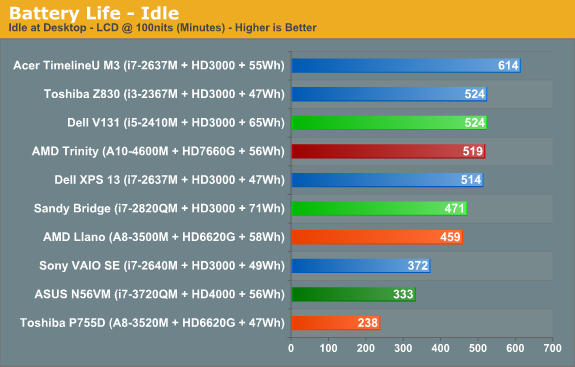
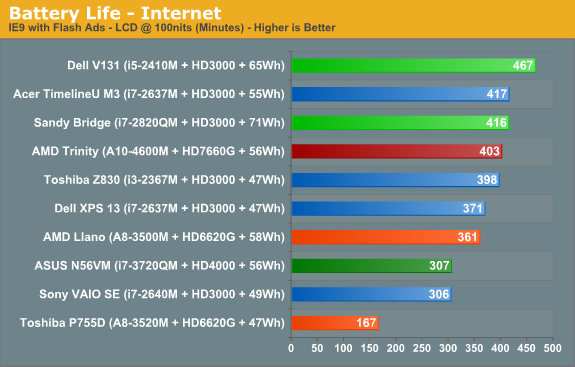
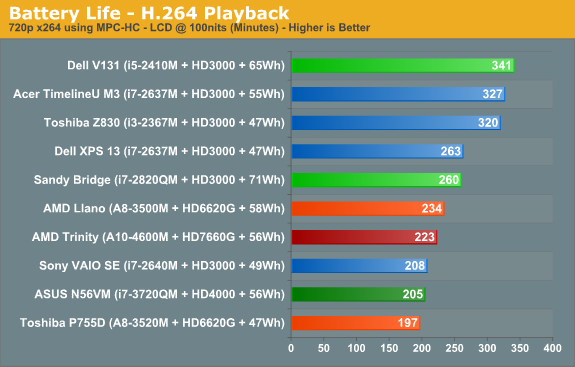
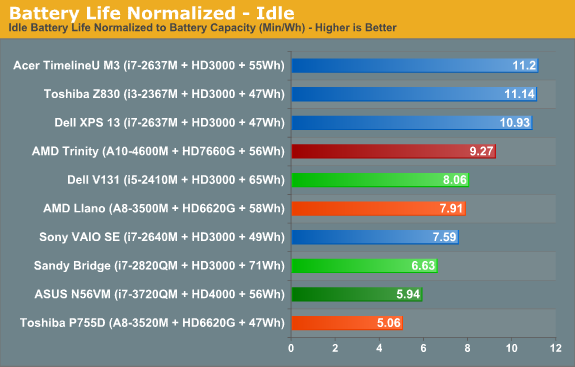

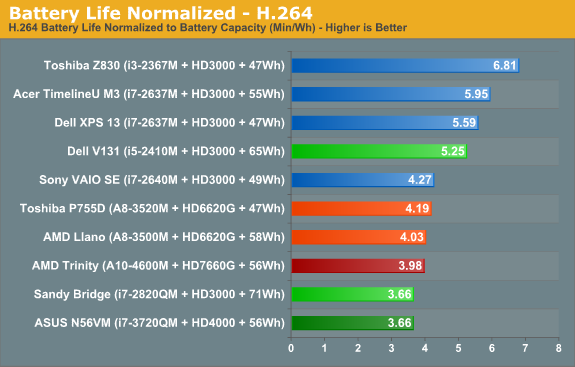
With a similar capacity battery to the original Llano laptop, and the same size 14” panel, Trinity comes out of the gates and posts two clear wins: idle battery life and Internet battery life are both up substantially relative to Llano. In fact, looking at the normalized charts, the only laptops that can consistently beat Trinity are found in Sandy Bridge ultrabooks—we won’t even bother discussing Atom or Brazos netbooks, as they’re competing in a completely different performance bracket. In something of a surprise, H.264 battery life doesn’t see the same benefit unfortunately, and it’s the one discipline where Llano still holds on to a slight lead over Trinity. Sandy Bridge meanwhile has always done very well in H.264 battery tests, and we see that with the Vostro V131 posting a normalized score that’s 30% better than Trinity and Llano. Of course, on the other end of the spectrum we have Ivy Bridge; we’ve only looked at one Ivy Bridge laptop so far, but if the pattern holds than Ivy Bridge will generally be a moderate step back in battery life relative to Sandy Bridge, giving AMD an even larger lead in this area.
We also performed a few other tests that we won’t present in graph form. One set of tests we alluded to earlier: the charts show Trinity with a Samsung 830 SSD, but we also ran tests with an Intel 520 SSD. Idle battery life dropped to 476 minutes (an 8% decrease), Internet battery life checked in at 371 minutes (down 8% again), and H.264 battery life stayed nearly the same at 217 minutes (down less than 3%). If battery life is one of your primary concerns, remember: all SSDs are not created equal!
Another test that we ran is simulated gaming; we looped the four graphics tests in 3DMark06 at 1366x768 until the battery ran out. We’ve run this same test on quite a few other laptops, and Llano initially looked to be far and away the best solution. Later, we discovered that when we tested Llano we were letting the GPU run in power saving mode—basically half the performance you’d get compared to being plugged in. We retested and measured 98 minutes, so the extra graphics performance comes with a heavy cost. We only tested Trinity (and Ivy Bridge and Sandy Bridge) using higher performance graphics settings, and this is one more area where it scores worse than Llano: Trinity managed just 77 minutes. That’s about the same as Ivy Bridge and Sandy Bridge (79 and 73 minutes, respectively), so if you’re after better gaming performance while running off the mains, you might need to keep looking.
Before getting too carried away with the above results, you still need to consider how important battery life is for your usage model. Some people travel a lot and like to go all day without plugging in; others will go from place to place and plug in whenever they’re not on the go. If you fall in the latter category, battery life isn’t usually a problem with any decent laptop, while those looking for all-day computing will definitely want as much mobility as possible. Ultimately, battery life is a factor of battery capacity as well as power optimizations done by the OEMs. We’ve seen battery life improve by as much as 50% when comparing two otherwise similar notebooks, but at least AMD’s reference platform for Trinity delivers a great starting point.
Temperatures and Acoustics
One other item we wanted to quickly touch on is system temperatures. We typically use HWMonitor and check temperatures of laptops under idle and load conditions. We did this with Trinity as well, but unfortunately the current version of HWMonitor doesn’t give us a lot of information. The only temperatures it reports are from the SSD and the HD 7660G graphics—there’s nothing about CPU core temperatures. That means we can’t provide much detail, other than to say that load temperature on the GPU topped out at 71C during extended testing, while the idle temperature was 39C. As usual, temperatures and noise levels go hand in hand, and the low 71C maximum GPU temperature matches up nicely with noise levels that never got above 37dB. It’s not the quietest laptop we’ve ever tested, and surface temperatures can get a little warm, but overall Trinity looks to be a good balance of performance and power requirements, which means quiet laptops are definitely possible.










271 Comments
View All Comments
Stas - Tuesday, May 15, 2012 - link
I agree with xd_1771. A mid-range CPU from 2 years ago is plenty for any CPU requirements an average user might have (Office, browser, IM, pr0n). The one thing that's been limiting laptops for generations is the GPU. AMD has brought serious graphics to laptop. Not only do you benefit through improvements in gaming and 3D software, with almost every resource intensive application becoming GPU-accelerated, you get better performance all-around.zephxiii - Tuesday, May 15, 2012 - link
I am using this old Thinkpad T60 with C2D 1.66ghz built in 4/2007 and it is plenty fast enough for regular use lol. The only thing that really sucks about it is the spinning HD in it.I use a T61p at home with C2D 2.2ghz and Quadro something HD with SSD and that thing does everything I need it to (Photoshop, lightroom, Internet, flash video etc.).
Both running Windows 7.
BSMonitor - Tuesday, May 15, 2012 - link
Nope, I promise that C2D 1.66Ghz lags for Flash enhanced./Java Runtime environments. Especially multitasking.Please, quit defining regular use with acceptance of slow. Drop even Core 2 Quad 9550 in that home PC, and I promise you would not go back.
Belard - Tuesday, May 15, 2012 - link
I have a ThinkPad R61 with PDC (Bottom end Core2 with missing cache) at 1.6Ghz. I bought for $550 off the shelf new when VISTA was about 8 months old. It came with XP-Pro, 1GB RAM and more importantly, a matte screen. I use it almost every day and since then I've added 1GB and Windows7 and it runs better than it ever did when it was new.Its slow compared to more C2Q Q6600, but the R61 does what I need for a mobile system. I sure don't like using Photoshop on it. But its mostly for browsing, Office apps and xfer of data/work.
It still faster than ANY Pentium4 class CPU.
I have an urge to go IvyBridge this year... but my Q6600 doesn't really keep me waiting much (other than video encoding) with 4GB / Win7. Nope, going on vacation this summer out-weighs a new computer. :)
BSMonitor - Tuesday, May 15, 2012 - link
Stop telling everyone what CPU is GOOD enough. There truly is software out there that my Core 2 Duo at work lags behind. My Core i7 system at home is remarkable smoother and more responsive. Neither with an SSD.tfranzese - Tuesday, May 15, 2012 - link
For a user who can't stand to wait, you've got your priorities screwed up if you're not using an SSD on those system.evolucion8 - Tuesday, May 15, 2012 - link
I wonder which kind of sofware tuns too slow on a C2D. I have a i7 2600K at 4.5GHz, much faster on WinRaR, media encoding, gaming etc. But running everyday tasks like web browsing, office, media playback etc, doesn't feel much different from my Core 2 T9300 and my i7 machine. My laptop does have very good encoding power which is very tolerable, but definitively my i7 destroys it, but considering that my C2D has a 35W TDP I don't loosing some performance for the sake of lower heat dissipation and battery consumption.vegemeister - Tuesday, May 15, 2012 - link
We were just getting to the point where a CPU could be good for 6-8 years, but then the web developers started making applications and desktop environments. Not to mention the horrors of flash and Java. What Intel giveth, web 2.0 taketh away.medi01 - Thursday, May 17, 2012 - link
Bullshit.Most of the web 2.0 is nowadays "also gotta run on tablets" and no way inhell it's "java based", or "flash based" or CPU intensive.
seapeople - Tuesday, May 22, 2012 - link
You people are a little crazy coming up with exotic applications that stress CPUs. It's much simpler than that.I'm running a Q2720m with Intel SSD and fiber optic internet, and I notice immediately if I turn turboboost off while browsing standard webpages with Chrome + Adblock. My browsing is noticeably CPU limited, especially in cases where I'm clicking through dozens of large webpages to find a specific page I'm looking at (such as browsing backwards through poorly designed blogs).
I would detest running something with the single-threaded speed of AMD's latest offerings. Of course, that's why I'm not in that target market.